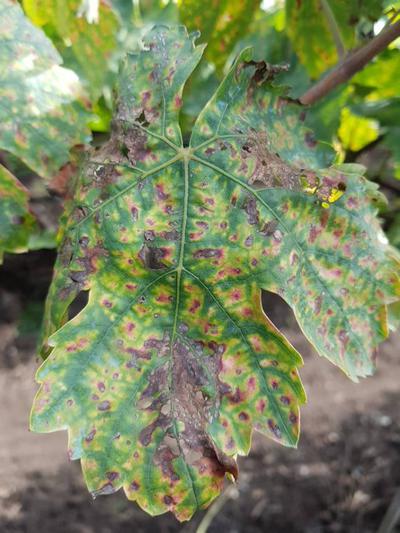Foot Rot
Cylindrocarpon
Nấm
Tóm lại
- Shortened internodes.
- Reduced leaf size and foliage.
- Yellowing and wilting of leaves.
- Dark lesions on roots and bark just above the ground.
Cũng có thể được tìm thấy ở
Triệu chứng
Young vines affected and show symptoms of shortened internodes, reduced leaf size and foliage. 3 to 5 year old vine leaves will turn yellow, wilt and eventually drop off prematurely. The roots are reduced and sunken, dark lesions are found on them which can cause wilting and die back of the whole plant. Purple discoloration of the root tissue is common. affected vines show reduced vigor with small sized trunks, shortened internodes, uneven wood maturity among others. The pith of affected vines will also show compaction and discoloration. Young vines are affected more rapidly whereas older ones show a more gradual decline. When young vines are attacked, they die very quickly, but as the vines age, infection results in a gradual decline and death may take more than one year occur.
Các khuyến nghị

Kiểm soát hữu cơ
As a preventive measure apply Trichoderma sp. on pruning wounds, basal ends of propagation material and graft unions. Treat dormant nursery vines with hot water at 50°C together Trichoderma. Soil amendments with Trichoderma spp., Mycorrhizae and compost is effective to boost plant resistance when plants are subject to stress situations.

Kiểm soát hóa học
Always consider an integrated approach with preventive measures together with biological treatments if available. As of today, no chemical methods have been developed against this fungi.
Nguyên nhân gây bệnh
The symptoms of black foot rot in grapevines is caused by several soilborne fungi of Cylindrocapon. Mainly young grapevines between 2 and 8 years are affected by the fungi. The fungi enters the vine through wounds or natural openings in roots. Grapevines are more prone to the disease when they are under water or nutrient stress. Heavy crop loads on young plants, poor drainage and soil compaction also favor the disease development.
Biện pháp Phòng ngừa
- Plant your vines in well-drained soil or raised beds.
- Only plant healthy and good quality vines.
- Avoid plant stress by using drip irrigating and fertilizing properly.
- Practice strict sanitation management of pruning or grafting wounds to protect the vines from disease entering.
- Dip your vines into waxes containing plant growth regulators or fungicides immediately after grafting.
- If possible, you should consider a fallow period before planting again.



